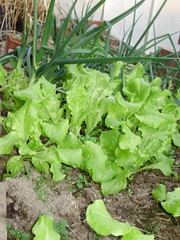 I spend a lot of time on the computer. But Spring is in the process of springing and that means that the garden beckons. I can see it from every window where I work in my little bungalow. From the office, I can see the green house, the hoop house and the herb garden. From the front window where I sit with my laptop, I can see the front yard, which we dug up last year to make room for strawberries, raspberries, blueberries and other assorted vegetables including onions and garlic.
I spend a lot of time on the computer. But Spring is in the process of springing and that means that the garden beckons. I can see it from every window where I work in my little bungalow. From the office, I can see the green house, the hoop house and the herb garden. From the front window where I sit with my laptop, I can see the front yard, which we dug up last year to make room for strawberries, raspberries, blueberries and other assorted vegetables including onions and garlic.
Growing our own food is one of the pleasures of our lives. We’ve been eating fresh lettuce from the green house for about a month now. It’s black seeded simpson, a leaf lettuce, that came up on its own, a by product of last year’s crop. Tonight, supper will include corn and tomatoes from the freezer combined with beans and butternut squash for chili.
Increasingly, growing our own food is also a way of showing our “green” side to the world. We want to eat locally, and our own background is about as local as we can get. We control the fertilizers and pesticides and always have enough to share with neighbors and friends. Of course, there is a debate over whether what I’m doing hurts third-world countries and really has much impact on global warming since transportation is a very small percentage of the emissions created by growing food, and I worry a bit, but I also know that I have never had a better tomato than one grown 100 feet from my house, picked fresh from the vine, dusted off on my t-shirt and consumed then and there, the taste of the sun and the soil still part of its flavor. I once read an argument about whether it was more environmentally friendly for the British to eat tomatoes grown in their country, not so tomato-friendly, or grown in Spain, very tomato friendly, and shipped to England. I think it came down on the side of the Spanish tomatoes. And, I had to laugh and admit to being a tomato snob: with the exception of those grape tomatoes that show up on restaurant salads, all our tomatoes, even the ones in the sauces we consume, come from our garden.
So, why is this a 21st century skill? Because growing something, whether it’s a cucumber in a pot on the porch or an acre of corn in the back field, gives you a connection to the earth that you don’t get in the produce aisle of the super market, a connection that is essential if we and future generations are to make good decisions about dealing with the environment. You learn about sun and soil and rain and nutrients in a way that is impossible from reading a textbook, doing a simulation or watching a television show. I’m all for putting the seeds in the paper cups so kids can watch the leaves emerge and grow. And, gardening includes lots of problem solving: Which vegetables don’t like being next to each other? Which ones can take some shade? Why are my tomatoes rotting on the ends and what can I do to fix it? What are the pros and cons of using hybrid versus heirloom seeds?
Schools are not really set up for gardening since they aren’t in session for most of the growing season. It’s ironic, since that schedule was set in place to accommodate farming families who needed their kids at home in the summer months to help with the family farm. Now, I suspect that few families need their kids to help with the chores. I would urge schools to join the community garden movement and make it part of their year round curriculum.